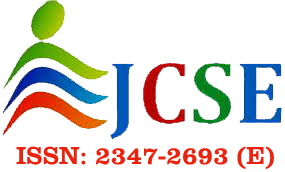Read2Me: A Cloud- based Reading Aid for the Visually Impaired
RA. Thomas1 , R. Ramanan2 , RA. Roy3 , S. Elisabath4
Section:Research Paper, Product Type: Journal Paper
Volume-5 ,
Issue-4 , Page no. 88-92, Apr-2017
Online published on Apr 30, 2017
Copyright © RA. Thomas, R. Ramanan, RA. Roy, S. Elisabath . This is an open access article distributed under the Creative Commons Attribution License, which permits unrestricted use, distribution, and reproduction in any medium, provided the original work is properly cited.
View this paper at Google Scholar | DPI Digital Library
How to Cite this Paper
- IEEE Citation
- MLA Citation
- APA Citation
- BibTex Citation
- RIS Citation
IEEE Citation
IEEE Style Citation: RA. Thomas, R. Ramanan, RA. Roy, S. Elisabath, “Read2Me: A Cloud- based Reading Aid for the Visually Impaired,” International Journal of Computer Sciences and Engineering, Vol.5, Issue.4, pp.88-92, 2017.
MLA Citation
MLA Style Citation: RA. Thomas, R. Ramanan, RA. Roy, S. Elisabath "Read2Me: A Cloud- based Reading Aid for the Visually Impaired." International Journal of Computer Sciences and Engineering 5.4 (2017): 88-92.
APA Citation
APA Style Citation: RA. Thomas, R. Ramanan, RA. Roy, S. Elisabath, (2017). Read2Me: A Cloud- based Reading Aid for the Visually Impaired. International Journal of Computer Sciences and Engineering, 5(4), 88-92.
BibTex Citation
BibTex Style Citation:
@article{Thomas_2017,
author = {RA. Thomas, R. Ramanan, RA. Roy, S. Elisabath},
title = {Read2Me: A Cloud- based Reading Aid for the Visually Impaired},
journal = {International Journal of Computer Sciences and Engineering},
issue_date = {4 2017},
volume = {5},
Issue = {4},
month = {4},
year = {2017},
issn = {2347-2693},
pages = {88-92},
url = {https://www.ijcseonline.org/full_paper_view.php?paper_id=1247},
publisher = {IJCSE, Indore, INDIA},
}
RIS Citation
RIS Style Citation:
TY - JOUR
UR - https://www.ijcseonline.org/full_paper_view.php?paper_id=1247
TI - Read2Me: A Cloud- based Reading Aid for the Visually Impaired
T2 - International Journal of Computer Sciences and Engineering
AU - RA. Thomas, R. Ramanan, RA. Roy, S. Elisabath
PY - 2017
DA - 2017/04/30
PB - IJCSE, Indore, INDIA
SP - 88-92
IS - 4
VL - 5
SN - 2347-2693
ER -
| |
|
|
| 714 | 630 downloads | 667 downloads |
Abstract
Reading is essential in our daily life. For the visually-impaired segment of the population, the inability to read has a substantive negative impact on their quality of life. Printed text (books, magazines, menus, labels, etc.) still represents a sizable portion of the information this group needs to have unrestricted access to. Hence, developing methods by which text can be retrieved and read out loud to the blind is critical. We use the computational power of resources made available by cloud computing providers for real-time image processing. There are many techniques which are used for navigating the visually challenged people, navigation in real time traffic is the main problem. The extracted text of various fonts and sizes then can be recognized individually and then combined in a word giving its output as audio using Text-to-speech using the SAPI libraries.
Key-Words / Index Term
SONAR,GPS,Navigation,Light Sensing,Pulse Sensing,Cloud,Assistive text reading,Binerization,OCR,Text-to-speech,Mobile cloud computing,pedistrial signal
References
[1] Y. Kanamaru, H. Suzuki, K. Asahi, A. Watanabe, “Proposal for a wireless sensor network visualization system using location estimation technology”, 2014 Seventh International Conference on Mobile Computing and Ubiquitous Networking (ICMU), Singapore, 2014, pp. 111-116.
[2] JR. Pleis, M. Lethbridge-Çejku, “Summary health statistics for U.S.adult :National Health Interview Survey”, National Center for Health Statistics, USA, pp.1-145, 2006.
[3] A. Helal, M. Mokhtari, B. Aldulrazak, “The Engineering Handbook of Smart Technology for Aging, Disability and Independence”, John Wiley & Sons, Hoboken, PP.1-480, 2008.
[4] R. Rivest, A. Shamir, and L. Adleman, “A method for obtaining digital signatures and public-key cryptosystems”, ACM Communication, vol. 21, no. 2, pp. 120-126, 1978.
[5] Amutha B, Ponnavaiko M, “virtual eye the blind child navigation model using wireless sensor, International Journal of Information Acquisition”, Vol.7, Issue.4, PP.88-92, 2010.
[6] Bharat Bhargava, Pelin Angin, Lian Duan ,” A Mobile-Cloud Pedestrian Crossing Guide for the Blind”, project report of Purdue University, USA, PP.1-48, 2011.
[7] SG. Sagar , GF. Khan, V. Nagaonkar, “A Wireless Navigation System For the Visually Impaired”, Capstone Research Project Interdisciplinary Telecom Program University of Colorado, Boulder, pp.1-10, 2015.
[8] A.S. Naik, S.M. Metagar, P.D Hasalkar, “A Survey on Secure Crypto-Biometric system using blind authentication technique”, International Journal of Computer Sciences and engineering,, Vol.2, Issue.5, pp.93-97, 2014 .
[9] H. Yoshiaki, S. Yusuke, S. Yuriko, Y. Kenji, “Development of the navigation system for the visually impaired by using white cane”, 2006 International Conference of the IEEE Engineering in Medicine and Biology Society, New York, pp. 4893-4896, 2006.
[10] Yogesh Badhe, Hafij Balbatti, Neelkanth Kaladagi , Kranti Kumar, “IRIS Recognition and Authentication System for Enhancing Data Security” , International Journal of Computer Sciences and Engineering, Vol.2, Issue.3, pp.1-5, 2014.
[11] A. K. Jain, A. Ross, and S. Prabhakar, “An introduction to biometric recognition,” IEEE Trans. Circuits Syst. Video Technol., vol. 14, no. 1, pp.4-20, Jan. 2004.
[12] C. Fontaine and F. Galand, “A survey of homomorphic encryption for nonspecialists,” EURASIP, vol. 1, no.2, pp. 1-15, 2007.
